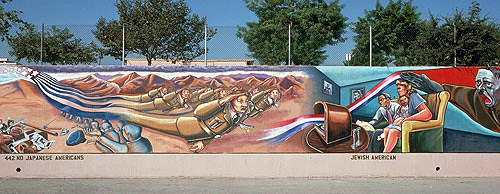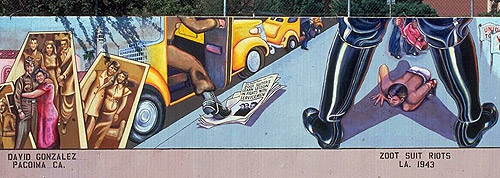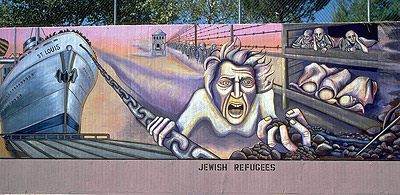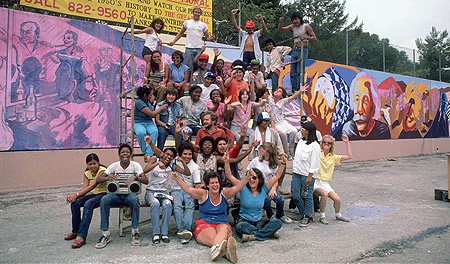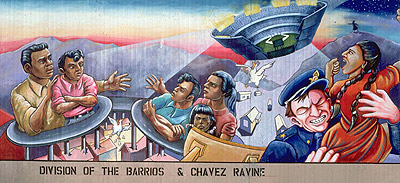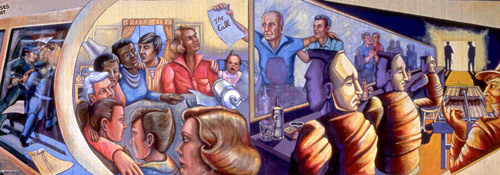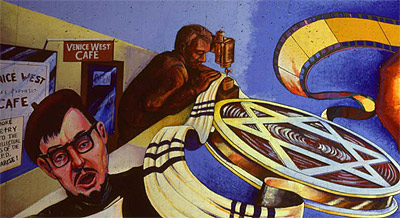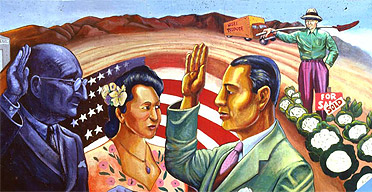 | The history of Los Angeles on Great Wall |
The 1930ís.The temperance movement''s axe looses a river of whiskey from the barrels of booze that the gangsters, symbolized by an Al Capone figure, used to become rich and powerful, while flappers dance in an "illusion of Prosperity." During this heyday of jazz, racial discrimination against Blacks continued. Black musicians and their audiences were not allowed in White hotels; only the now fabled Dunbar allowed them to stay in Los Angeles. Above the musicians, between the hotel and a bank beginning to topple in the crash of 1929, a Black worker drinks from a fountain marked, "Colored Only." |
Crash and Depression. In spite of the efficiency of the assembly lines, the cornucopias of prosperity and the fantasies of romance produced by Hollywood''s movie industry, the depression is inevitable. It cannot be hidden by the Hollywood fantasies, which only serve as a facade that tries to cover up the reality of the breadlines behind. While the unemployed sell apples and warm their hands on a trash can fire, the marching feet of the unemployed lead directly into the strikes against low wages.The strikers symbolize the beginnings of the militant union movement of the Thirties and show the brutal repression. Victimized by invalid treaties, Native Americans are forced to sell two thirds of their land to developers at 45 cents an acre. Three hundred fifty thousand Mexican‑Americans are rounded up and shipped across the border in mass deportations |
The 442nd Japanese‑American infantry division comes out of the stripes of the American flag‑yet, in the shadow of these stripes, Japanese‑Americans move backward toward the internment camps depicted in the previous section, forced to discard their possessions as they go. The mural continues to explore in turn the contradictory situation of each of the other ethnic minorities in California. A Jewish‑American family, in the shadow of Hitler''s hand, listens to the news from Europe. Hitler''s other hand is a fist. From it goosesteppers lead toward an antiFascist rally in Los Angeles and toward World War II. Below, on the homefront, is the building of the California Aqueduct which transports water from north to south to aid developers, but creates a desert in the Owens Valley region. The World War II segment shows Jeanette Rankin in Congress below and Pearl Harbor above. A group of generals and businessmen plan the war effort; from that cooperative effort stream the lines of soldiers, arms and women war workers. |
The contradictions in the Chicano experience are expressed by contrasting the experience of Chicano servicemen with that of discrimination at home. David Gonzalez, a local Chicano Congressional Medal of Honor winner, is shown standing with his mother, in a collage of photos from a family album. In the next panel, taxis bring servicemen into Los Angeles for the Zoot Suit Riots in which Mexican-American boys wearing Zoot Suits were stripped and beaten by marines with the consent of the police. Trains carry "braceros," Mexican farm workers, contracted to work temporarily in the California farm fields. The struggle to organize the farm workers and demands for more humane working conditions are represented by the portrait of labor organizer Luiso Moreno, who is wrapped in the flag of the Congress of Hispanic Groups |
40s. Jewish Refugees. Parallel to the train bringing migrant workers is the St. Louis, the ship filled with Jewish European immigrants which was refused entry to the U.S. because the Jewish immigration quota was already met. The spirit of these starved and suffering Jewish victims of the Holocaust emerges from the ship and reaches for American soil. Behind are depicted the death camps where the Germans murdered more than six million Jews. Beyond the death camps is the mushroom cloud of the Atomic Bomb, another symbol of death, and beyond that the founding of Israel and the greening of the desert. The end of the War brings in a spurt of prosperity ≠tract houses and a baby boom! In the kitchen of a typical tract house in the San Fernando Valley (the rest of the development can be seen through the window) a baby screams. On the television Ronald Reagan stars in a 1940''s era war movie. Outside, peering through the plate glass windows at the "American Dream," the Soldiers of Color discover that little has changed for them on their return. |
The 1950''s section was painted in the summer of 1983 with a crew of 30 youth, seven artist supervisors and muralistdirector Judith Baca. This 350‑foot segment attained sponsorship from such groups as the National Endowment of the Arts, the California Council for the Humanities, the Los Angeles Olympic Organizing Committee and numerous other groups and individuals. With the aid of over a dozen humanist scholars and historians, workshops and programs were held for the muralists in selecting, designing and enlivening the images |
During World War II, millions of American women left their traditional roles as housewives and entered the war industries as manual laborers and managers. But in the post‑war years, "Rosie the Riveter" returned to the kitchen as the men returned home and reclaimed their power and position in labor. Women''s access to work positions traditionally dominated by men was postponed. The television set propagates mass social images of the housewife and depicts a working woman being sucked into the T.V. image |
Joseph McCarthy, the infamous proponent of the 50''s "Red Scare," holds up a blacklist, naming film industry people who are accused of being Communist activists and sympathizers. The "Hollywood Ten," a group of Hollywood producers, directors, writers and actors, are subpoenaed and found in contempt of Congress for refusing to answer McCarthy''s charges. Consequently, they are blacklisted and shunned, their professional and personal lives nearly ruined. A typewriter, tied and bound by the lists, represents the fear of being blacklisted and the repression of social criticism and freedom of speech. In the background, Sputnik hovers over the scene, reminding the viewer of the Soviet Union''s techno‑military progress which so startles and frightens America. |
Freeways encircle and dislocate various areas in L.A., effectively dividing minority communities. In this panel, a Chicano family is separated by the serpentine thoroughfares as the pillared highway breaks through the roofs of houses. Resembling a UFO, massive Dodger Stadium descends from the twilight sky into Chavez Ravine. A bulldozer and policemen forcibly uproot the Chicano community so that Dodger Stadium can be built on land designated at one time for public housing. Many individuals resisted this forced eviction from their neighborhood, but to no avail |
Pop 50''s culture is captured in this scene at a drive‑in theater. A huge Elvis Presley wails his rock songs from the silver screen, but behind him a smaller image of Chuck Berry acknowledges the original force of rock''s creativity and inspiration in the Black community. Various hotrods and lowriders, face the screen, as a starspeckled sky forms the background. Behind the movie screen and Elvis, Black musicians again testify to the spirit and contribution of the Black community to popular culture. Jazz saxophonist Charlie Parker and Blues vocalist‑caller Big Mama Thorton (who wrote "Ain''t Nothin'' But A Hound Dog" which Elvis popularized without crediting her) perform. Behind these Black musicians, a Charles White portrait of a Black woman holding up South L.A. portrays the sustaining community activism of Black women in volunteer and church organizations. This scene emerges with another depicting the interior of a local bus. Paul Robeson, Rosa Parks, Gwendolyn Brooks, Ralph Bunche and Martin Luther King, Jr., are rising from their bus seats and moving forward for new destinations (Civil Rights). |
The 1950''s witnessed the emergence of homosexual community organizing, represented in this panel by the first gay/ lesbian publications and social change organizations. As police enter the closet to repress the homosexual community through violence and entrapment, women forming the first lesbian rights organization, the "Daughters of Bilitis," meet in a kitchen and mimeograph copies of their newsletter, "The Ladder," copies of which float out of the closet above the heads of the police. In a gay bar, solitary men sit in front of mirrors, cautiously glancing at one another, fearing entrapment by vice officers. Each wears a mask at the back of his head symbolizing the false front to society gays had to assume to avoid persecution. In the mirror, the men see themselves as they wish they could be‑warm, affectionate, caring. The masks also represent the Mattachine Society, founded in 1950 by among others Harry Hay depicted here issuing his call to organize. Inspired by the masked Mattachine male dancers of medieval France, the Mattachine Society was the first to advocate social equality for homosexuals. |
In this panel, the Beat movement represents another popular underground movement which was harassed by the Establishment. Various Venice cafes sponsored Beat jazz sessions, abstract art exhibitions and poetry readings. But disgruntled conservatives moved to halt these activities and close the cafes, provoking Beats to protest |
Just as Jewish writers like Allen Ginsberg took risks in developing a new creativemovement, Jews in Los Angeles started out in high risk businesses which, by the1950''s, had become among the most important in California. New York garmentworkers become recyclers of rags in Los of Angeles and, eventually, the backbone of the garment industry. Also high risk in the 20''s was the fledgling film industry built by Jewish studio owners into highly Suc≠cessful enterprises. Finally a huge image of Albert Einstein holding a diagram of an atom reveals his concern that atomic power be used for peaceful purposes but not war |
Despite harsh immigration quotas, Asian Americans made progress in the Fifties by attaining naturalization and land ownership rights. A Korean civilian is sworn in as the first to be granted American citizenship. Behind the scene, a Japanese farmer stands proud in his newly purchased field, depicting the gains of Japanese Americans also to become citizens and to own land |
The wall ended with Olympic Champions 1948‑1964 Breaking Barriers. In this final panel, a woman runner carries the Olympic torch, its flame and smoke swirling into scenes of athletes who overcome tremendous obstacles to win Olympic events. Billy Mills, a Dakota 0glala marathon runner, overcame his repression in boarding schools to become an important symbol for Native American pride. Black runner Wilma Rudolf, overcoming her childhood infirmities (being unable to walk until her eighth birthday) throws away her leg braces and wins three gold medals, the first American ever. Sammy Lee, a Korean American diver, and Vicky Manalo Droves, a Filipina diver, win gold medals as well. The symbolic final runner carries the torch of the 1950ís into the civil rights movements of the 1960ís.
Now, in project,
The 60''s
Our narrative begins with an image of activists, with their backs turned towards the viewer, sitting at a lunch counter. An unhappy waiter crosses his arms, and scowls at the black patrons sitting at the counter. In the background a sign reads, ďWhite Only.Ē One gentleman gets up from the counter to join in a march in the distance, while the another man looks on. The March represents a combination of all the freedom marches, but mainly the protestors for integrated schools in Birmingham, AL. Below the march, protestors meet resistance from police, armed guards, and dogs. Firemen and police spray men, women, and children, with powerful water hoses. Bull Connor appears above the police, encouraging them to be forceful. The water from the hoses moves like a snake to irrigate a farm field.
The water changes into a line of people following Cesar Chavez. These brown-faced people are Mexican and Filipino farm workers, who have joined the UFW. Opposite Chavez is a farmowner, who is closing a gate to the field. Workers are standing outside of the gate, looking in. This image represents the end of the Bracero program in 1964. The crops and the landscape change shape, into a rice field in Vietnam. At this point, there is a helicopter above the fields representing the war in Vietnam. A solider walks through the field with a blindfold of the American flag, over his eyes. This is a direct reference to the artwork of David Hammonds, an African-American artist of the time. In the background four women, from the Long Haired Army, are surveying the land with binoculars.
The explosions from Vietnam turn into a domestic explosion from the 1965 Watts uprising. Buildings are burning, and a sign in store reads, ďBlack Owned.Ē On the street young men are running. One of the young men becomes an Olympic runner, with his fist in the air to represent Black Power. Pictures of Huey Newton / Bobby Seale, might be posted on the walls.
In 1965 the Immigration and Naturalization Act, was passed, allowing immigrants of color to come to the United States. Before the act, 3/4 of immigrants were Northern European; after the act, 2/3 of the immigrants were Latino and Asian. On this segment, there will be a house with an unusually big front door. A Korean family will be entering the house with suitcases in hand.
Perhaps the most difficult image to produce for the 1960ís will be the assassinations of JFK, MLK, Malcolm X, and Robert Kennedy. Their deaths marked the end of an era of hope, and the fall of faith in the government. Many photos taken right after the assassinations illustrate how devastating it was for the public. In this segment, people will be pointing from a balcony, similar to the photo taken after Kingís murder. People will be pointing from the ground to the buildings, above. Posters of MLK, JFK, and Malcolm X, will be on the ground, and people will be running in panic.
The next scene will be the finale to the decade. In 1968, Sal Castro led the East Los Angeles walkouts, which included 10,000 high students. Other images in this decade will include the American Indian movement (led by Chippewas George Mitchell) and occupation of Alcatraz , as well as pop music such as Otis Redding, Jefferson Airplane, Jimi Hendrix, and Janis Joplin
The 1970s - in the work of professor Judy Baca and her UCLA class
The 1980s
The 80s was a time of lingering occurrences overshadowed and dominated by the Reagan regime. The slow movement of the entire mural reflects the shroud of ReaganomicsóRepublicans rule and the world follows. Reagan is a constant figure and appears in the beginning of the mural with his masked bust floating in the background and then disappearing into the foreground. The mask reflects the charismatic leader that the Republican public grows to love, while the real face peeking from behind is the reality that results from the imperialistic, militaristic, and aristocratic climate of the Reagan era. Missiles circulate his head and launch off into the sky representing the global arms race, coming closer to the foreground and becoming more significant towards the middle of the decade, when global relations focused on military and arms.
The pervasive Reagan Cloud lingers above his head and floats through the entire mural, morphing and changing with the social climate and the activity in the sky. Missiles follow behind the cloud and the missile in the center breaks through and travels to the foreground suggesting the direct relation between the Reagan era and weapons armament. The missiles play the role of the intimidator and symbolize the imperialistic nature of the US in the 80s. The morphing Reagan cloud evolves into lunar nebulae towards the middle of the decade with the constant activity in the cosmos. Satellites float in outer space and control the new technology while facilitating communication with the world. Halleyís Comet travels in the background, continuing with the outer space theme, and crashes into a missile and the Challenger Space Shuttle. As the sky changes again from outer space to smog, the hole in the ozone layer becomes more apparent, symbolizing growing awareness of the depletion of nature at the hands of consumer culture. The cloud then begins to disintegrate towards the end of the decade and the end of Reaganís presidency, but a few clouds still linger just as the repercussions of Reaganomics continue to be present in contemporary society.
The activity on the ground echoes the movement of the sky. Earthquakes run from the far left, disappear in the center and reappear on the right. As the cracks divide the land in the piece, they also provide a continuity that exists throughout the decade by compositionally opening the piece up focusing the attention on the movement of the mural as a whole. The cracks represent the earthquakes in Mexico (1985), El Salvador (1986), San Francisco (1989), and Whittier (1988). Oil flows in and out of the cracks at the beginning of the piece representing the oil crisis in the Middle East and the relationship of its affects on the U.S. The theme of oil in the mural continues with the Exxon Valdez oil spill in 1989 that caused resounding environmental effects.
Another significant image in the mural is of Central American immigration to the U.S. as a result of civil wars funded and supplied by the U.S. government. The U.S. in turn saw a rapid increase in the number of Central American immigrants in the 80ís. In the far left, behind Reaganís translucent shoulder sits a neighborhood of houses in traditional Salvadorian painting style, from which emerge a group of immigrants trailing down a hill past the earthquake fault cracks, through Reaganís translucent image towards the background, continuing through the mural until they gather in a large group in the center flowing into one family. The family in the foreground is a dominant aspect of the mural that personalizes the struggle and long journey, which many families have had to face coming to the U.S. The family stands in front of a border crossing sign marking the contrast between what the government wants people to think about immigrants and what they actually are. The three figures stand in heroic positions, their soulful eyes and demanding gaze force the viewer to recognize their powerful existence in U.S.
An image of Nancy Reagan holding a ďJust Say NoĒ sign stands in the palm of Reaganís hand representing her campaign against drugs. It is depicted in brighter or pastel, non-realistic colors, as they signify the lies and cover-ups that the public was spoon-fed. The earthquake crack alongside Reaganís hand ties into the drug scandal that erupted over the involvement of CIA officials in the selling of crack cocaine to minority neighborhoods, whose profits went towards the purchase of weapons that supported the wars in Central America.
The effects of Reaganís presidency on homelessness can be seen near the center of the piece with the foreshortening of hospital beds fading into the horizon line and returning to the foreground as images of homeless people sleeping on the sidewalk, which is a direct result of Reaganís policies. The eighties are a significant decade for public awareness of the AIDS virus, strengthened by the death of Rock Hudson, the first public figure to die of AIDS. Though not yet fully researched popular culture of the eighties will be included through art styles, hip-hop culture, movies, etc. We will also include a sort of magical realism depiction of the way immigrants perceived the U.S., as a paradisical ďnorthĒ, as well as the reality they found when they arrived here, such as jobs as day laborers, costureras, naranjeros, and domesticas.
The mural will conclude with an image of the fall of the Berlin Wall symbolizing the end of the Cold War. This image will allow the transition between the eighties and the nineties. The Panama Invasion will also be included as another bridge to the nineties.
The nineties were transitional years in America and all over the world. It was a decade which began with fierce conflict both domestically and abroad. Music and popular culture in America reflected aspects of these conflicts and they evolved through a number of different trends and genres in swift succession. The young people coming of age during this period witnessed the rift between the "haves" and "have nots" widen as opportunity for education and social advancement became increasingly difficult to pursue. This was the decade which saw the rise of the internet, a phenomenon that enabled a flow of information to stream across vast distances. Globalization was fueled by this technological development and individuals as well as organizations began to devise strategies in order to take advantage of the new circumstances. Social environments like those found in American cities such as Los Angeles were changing also. As the approach of the new millennium drew near, residents of the huge metropolis came to exist in a state of transit, speeding towards the year 2000. In March of 1991, The city public was shocked by an amateur video of a motorist being beaten by Los Angeles Police Officers. The motorist was Rodney King. One year later, a jury acquitted all four of the officers shown beating King on the video tape. The reactions of the city to the "not guilty" verdicts were heard all over the world. South Central Los Angeles ignited into a three day riot. The situation became so severe that the national guard was eventually called to restore order. After the riots, artists and musicians of Los Angeles produced work that reflected anger and contempt for law enforcement. "Gangster Rap" became a popular genre of hip hop music. The Los Angeles based rock band, "Body Count", released a tune called "Cop Killer". But it was not just Los Angeles artists who were feeling contempt for their environment. Another genre of music emerged in the early 90''s that characterized the disposition of young people coming of age amidst turbulent current events. This was the music of Seattle''s "Grunge" scene. Kurt Kobain, the lead singer of "Nirvana", unwittingly became the icon of the Grunge sound and of adolescent angst in the 1990''s. In the mid 90''s Technology had a "WWW revolution" asthe internet became widely used. Technology on the whole seemed to be developed at an accelerated rate. New innovations were appearing every day, making technology developed perhaps only a year earlier obsolete. This boom in technology encouraged globalization. Corporations took full advantage of new tools like the internet and they spread their organizations as far as possible. In this climate of advanced technology, it became increasingly necessary to be educated. Education enabled one to navigate the complex system of our society. But education was hard to obtain. Propositions 209 and 227 put "higher education" even higher out of reach for many people. Furthermore, the path of the "super highway" was not the goal of everyone. While some members of society seemed destined to move towards a future which was defined by this "super highway", others were clearly not interested in the same goals. "Higher education" seemed too far of a stretch for people who planned to live perfectly meaningful lives distinct from the fast paced "highway" route. Yet as the year 2000 approached and the "Y2K" scare mounted, people on the "super highway" began to panic. Society had become dependent on the new technologies which they had produced. The threat of a wide spread "crash" of information would have been devastating. But people as a society would have to take responsibility for their creations.
- Geer DuBois
The fall of the Berlin Wall brought an end to the Cold War, however the oil that seeped out from the crumbling mortar ignited the Nineties with the Gulf War and the smoke of the oil fires circling the globe. Amid the gray landscape, two children play a video game. This video game represents how the United States Military were trained to bomb Iraq, by using video games, a tactic to make the enemy appear less than human.
From this war ravaged land a wall arises and runs throughout the length of the mural. It is the border fence, separating the United States from Mexico. The metal utilized by the U.S. military to build landing strips for aircrafts was exported back to the United States and used in the construction of the border fence. The imaginary line separating the United States from Mexico has been a land of increased militirization, resulting in increased injuries and deaths.
In Los Angeles, another fire erupts, a result of the Rodney King beating and subsequent trial that ricocheted into a riot and left the city charred.
Perhaps no decade could better fit the term Ďsleepwalking democracyí in the wake of the anti-immigration laws that succeeded in passing and the countryís prison population increasing monumentally even


